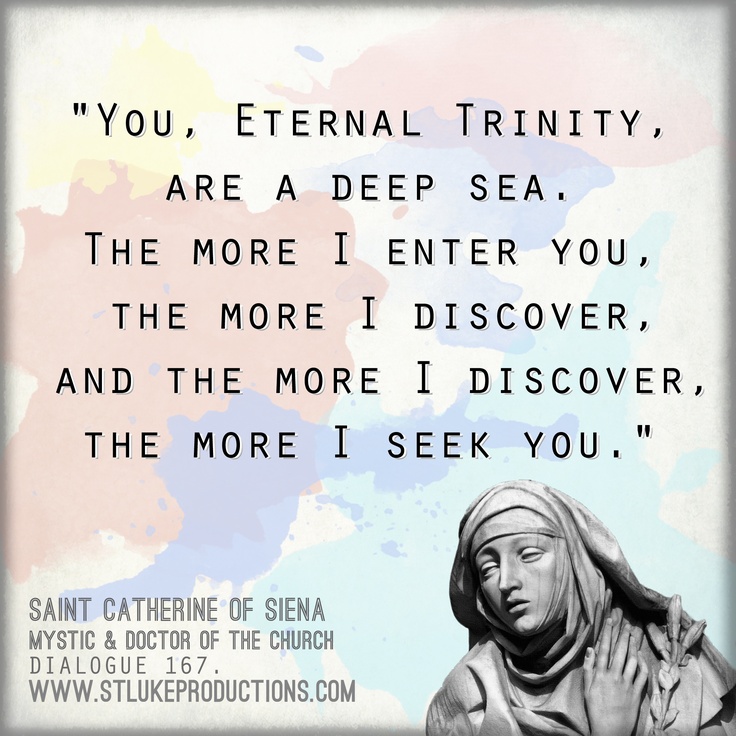Today, April 29th is St. Catherine of Siena’s feast day. She is the patron saint of this blog and one of my personal patron saints. I try to honor this day every year.
Last year on this date I mentioned acquiring three of the four volumes of her annotated Letters. Just as last year I want to highlight a particular letter in honor of this day.Letter T41/G105/DT3, from The Letters of Catherine of Siena, Volume 1, Translated and Annotated by Suzanne Noffke, O.P., Arizona Center for Medieval and Renaissance Studies, Tempe, Arizona, 2000.
To Frate Tommaso dalla Fonte, in San Quirico. Noffke dates this letter as before 1374 but possibly 1368, making her 21 years old, and a year after she famously exited her self-imposed cell. Tommaso is her cousin who as a child came to live at Catherine’s household, and so they grew up as siblings. Tammaso has become a Dominican friar and priest at the time of this letter, and is living away from Siena in San Quirico. I’m going to take one key paragraph from this letter which is thick with Catherine’s theology.
Dearest Father, I beg you to fulfill my longing to see you united with and transformed in God. But this is impossible unless we are one with his will. Oh sweet eternal will, to have taught us how to discover your holy will! If we were to ask that gentlest most loving young man and most merciful father, this is how he would answer us: “Dearest children, if you wish to discover and experience the effects of my will, dwell within the cell of your soul.” This cell is a well in which there is earth as well as water. In the earth we recognize our own poverty: we see that we are not. For we are not. We see that our being is from God. Oh ineffable blazing charity! I see next as we discover the earth we get to the living water, the very core of the knowledge of God’s true and gentle will which desires nothing else but that we be made holy. So let us enter into the depths of that well. For if we dwell there, we will necessarily come to know both ourselves and God’s goodness. In recognizing that we are nothing we humble ourselves. And in humbling ourselves we enter that flaming, consumed heart, opened up like a window without shutters, never to be closed. As we focus there the eye of the free will God has given us, we see and know that his will has become nothing other than our sanctification.
I am always amazed at how a young uneducated girl could reach such heights of theological reasoning. I am also amazed at how she as a twenty-one year old has the chutzpah to instruct an educated priest. First she implores the friar to holiness by uniting his will with that of God. And then she has a rhetorical flourish by switching perspective and offering advice on how to do so by speaking through the voice of God: “Dearest children, if you wish to discover and experience the effects of my will, dwell within the cell of your soul.” Here she speaks of her concept of the soul as a “cell” from which you can reach God. Then she uses the metaphor of a well to explain the cell. It contains earth, which is our poor humanity, but deeper one reaches a spring of water, where we reach God. Of course there is the Biblical allusion there of the woman at the well in John’s Gospel.
There are a couple of other concepts in that short paragraph. She says in recognizing our poverty in the earth that “we see that we are not.” Noffke annotates this as an early expression of Catherine’s future, more developed thought that “God is, and we are not.” It is the realization that God creates us and maintains our existence through His will, and that our will has nothing to do with our existence.
In realizing this poverty of humanity, we humble ourselves before God. And in this humility we are able to enter into Christ: “we enter that flaming, consumed heart, opened up like a window without shutters, never to be closed.” Noffke’s note here is that Catherine is alluding to Christ as the door, taken from a Sermon from St. Augustine of Hippo, “the entrance opened for you when his side was pierced with a lance” (Sermones CCCXI, Chapter III). Catherine could be alluding to St. Augustine, but I find it hard to believe she read it. The open hole in Christ’s side is an image she could have picked up anywhere. Nonetheless, this is a remarkable passage of profound theological insight.
So
go deep into the well of your soul and find God’s will. St. Catherine of Siena, pray for us.




No comments:
Post a Comment